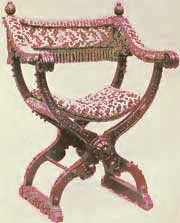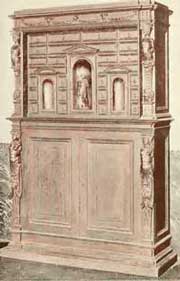Italian Renaissance Furniture
The Italian Renaissance furniture was influenced by the new interest in Greek and Roman antiquities, and benefited from the interest in arts of many wealthy people.

Italian Curule chair, 16th Century
As with the Gothic furniture, the Italian Renaissance furniture design was guided by architectural principles.
The return to classic forms in the 15th century had immediate results in the form and ornamentation of the furniture. Following the architectural lines, cabinets and paneling displayed colonnades, the fronts of cupboards and presses often looking like miniature basilicas and palaces.
The Renaissance spirit found its fullest expression in carving, and to such an extent that cabinet-makers from all over Europe came to learn from their Italian counterparts. During the period, this resulted in all the European furniture styles being heavily influenced by the Italian Renaissance.
The Italian Renaissance furniture style had a seigniorial, palatial character, rather than a domestic one. The lines and proportion in classic details had Florence as the leader, without neglecting the ornamental details, while the Venetian furniture was even more elaborate.
Carving was the main ornamentation of the Italian Renaissance furniture. The cabinet-makers partially abandoned the oak, which was the common wood of the Gothic period, and began to use walnut, chestnut, and other woods, which were better suited for fine, detailed carving.
The unique Italian Gothic was already coexisting with Renaissance elements since the 14th century. The decorative Italian styles lagged somewhat behind the architecture, and Gothic details persisted more or less until the true classic revival of the 16th century.
The lives of saints came to play a less prominent part in the carving, mythological and historical subjects in a pictorial form taking their place. The ornamentation details included the acanthus, the cartouche, or the scroll. Floral motifs, human figures, or chimeras were also subjects of the intricate carving, in high or low relief.
The Italian Renaissance furniture was also displaying inlaid ivory and bone into ebony or walnut . Cabinet makers were using a type of decoration called intarsia, imitating marble mosaics. It consisted of inlays of wood, natural or stained, etched and scorched with hot sand or iron, and polished with oils.
During the 16th century, the "pietra dura" decoration came into fashion. It was similar to intarsia, this time the inlay consisted of highly polished stones like agates, marbles, or lapis-lazuli.
The cabinet was one of the most important pieces of the Italian Renaissance furniture. With its palatial, architectural character, it was imposing, at times even monumental. It was richly carved and inlaid.
Italian Renaissance chairs were numerous, either with high-back, or of curule form (the Savonarola chair). The high-backed chairs were of state majesty, richly carved, and perpendicular in form, with square seats. To make them more comfortable, cushions of leather, silk or velvet were used. The wood used was either oak or walnut.
The curule chair, being smaller, was more comfortable. It had an X shape, of Roman inspiration. Frequently it was made as a folding chair, very handy for persons of rank travelling. Made mostly of Italian walnut, the curule chair was carved, sometimes gilded. The back was made of stretched leather or velvet, while the seat could be made in the same manner, or of wood, with a cushion placed on it.
Towards the end of the 16th century, upholstered chairs appeared, with the upholstery made in silk, tapestry, or leather.
Italian Renaissance furniture tables were more elegant then their medieval counterparts. They were rectangular, supported by solid carved, shaped consoles, often ending in a claw or scroll feet. The consoles were connected by a heavy stretcher. The tops were wooden thick planks decorated with inlay and gilding, or slabs of marble.
A common piece of the Italian Renaissance furniture was the cassone, the marriage chest, where the wedding gifts were kept. Made of walnut, oak, or cypress, the chests were carved, painted, or gilded. They could have a sarcophagus form, or could have all their sides perpendicular.

